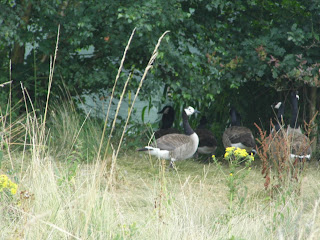Mid-August 2021
One of our favourite Breckland locations is Brandon Country Park, so we headed there over the summer. The cafe was open for outdoor dining, so we had lunch on the tables nearby before heading past the lake and out towards the heath before looping round and back through the woods. Probably one of the most interesting sightings came early on when Cathy noticed an Oak Bush Cricket under a leaf. When I looked closely at it I noticed the eyes seemed un-naturally red and the abdomen seemed to have almost 'melted' onto the leaf. Having posted it on Twitter fortunately Brian Eversham recognised the signs of it having been parasitised by a fungus, Enthophaga grylli. Having flagged this up, several other people also reported seeing similarly parasitised Oak Bush Crickets in different counties around the same time.
Elsewhere on the track we saw a Large Shaggy Bee (Panurgus banksianus) and the burying beetle Nicrophorus vespillo. Further round I checked some Broom and found the treehopper Gargara genistae, something of a Breckland speciality in East Anglia, whilst Cathy noticed some Buff-tip caterpillars.
Before leaving we had a look around the walled garden and saw galls of Rhopalomyia tanaceti on Tansy flowers in the flowerbed.





















































